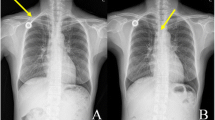Summary
This study aimed to investigate the causes and managements of the fractures and migrations of the implantable venous access port catheter (IVAPC). The fracture or migration of IVAPC occurred in 4 patients who were treated between May 2012 and January 2014 in Union Hospital, Wuhan, China. The port catheter leakage was found in 2 cases during drug infusion. Catheters that dislodged to the superior vena cava and right atrium were confirmed by port angiogram. The two dislodged catheters were successfully retrieved by interventional procedures. Catheter fracture occurred in two cases during port removal. One catheter was eventually removed from the subclavian vein through right clavicle osteotomy and subclavian venotomy, and the other removed by external jugular venotomy. Flushing the port in high pressure and injury of the totally implantable venous access port (TIVP) during implantation are usually responsible for catheter displacement. Interventional retrieval procedure can be used if the catheter dislodges to the vena cava and right atrium. Catheter fracture may occur during removal if clipping syndrome occurs or the catheter is sutured very tight during implantation.
Similar content being viewed by others
References
Chernecky C. Satisfaction versus dissatisfaction with venous access devices in outpatient oncology: a pilot study. Oncol Nurs Forum, 2001,2(8):1613–1616
Kurul S, Saip P, Aydin T. Totally implantable venus-access ports: local problems and extravasation injury. Lancet Oncol, 2002,3(11):684–692
Babu R, Spicer RD. Implanted vascular access devices (ports) in children, complications and their prevention. Pediatr Surg Int, 2002,18(1):50–53
Maisey NR, Sacks N, Johnston SR. Catheter fracture: a rare complication of totally implantable venous devices. Breast, 2003,12(4):287–289
Cho JB, Park IY, Sung KY, et al. Pinch-off syndrome. J Korean Surg Soc, 2013,85(3):139–144
Nagasawa Y, Shimizu T, Sonoda H, et al. Is catheter rupture rare after totally implantable access port implantation via the right internal jugular vein? Report of a case. Surg Today, 2014,44(7):1346–1349
Kao CL, Chang JP. Catheter fracture and embolization from an implanted venous access device. J Emerg Med, 2002,22(1):95–96
Lin CH, Wu HS, Chan DC, et al. The mechanisms of failure of totally implantable central venous access system: analysis of 73 cases with fracture of catheter. Eur J Surg Oncol, 2010,36(1):100–103
Wang Q, Xiong B, Zheng C, et al. Percutaneous retrieval of PICC fractures via the femoral vein in six cancer patients. J Vasc Access, 2015,16(1):47–51
Cheng CC, Tsai TN, Yang CC, et al. Percutaneous retrieval of dislodged totally implantable central venous access system in 92 cases: experience in a single hospital. Eur J Radiol, 2009,69(2):346–350
Liu JC, Tseng HS, Chen CY, et al. Percutaneous retrieval of 20 centrally dislodged Port-A catheter fragments. Clin Imaging, 2004,28(3):223–229
Ku YH, Kuo PH, Tsai YF, et al. Port-A-Cath implantation using percutaneous puncture without guidance. Ann Surg Oncol, 2009,16:729–734
Osawa H, Hasegawa J, Yamakawa K, et al. Ultrasound- guided infraclavicular axillary vein puncture is effective to avoid pinch-off syndrome: a long-term follow- up study. Surg Today, 2013,43(7):745–750
Shimizu T, Mekata E, Murata S, et al. A case of catheter fracture of a totally implantable access port introduced through the rightinternal jugular vein. J Surg Oncol, 2011,103(5):460–461
Gowda MR, Gowda RM, Khan IA, et al. Positional ventricular tachycardia from fractured mediport catheter with right ventricular migration—a case report. Angiology. 2004,55(5):557–560
Kalra VK, Arora P, Lua J. Spontaneous fracture and migration of distal segment of a peripherally inserted central venous catheter to heart in a neonate. J Vasc Access, 2012,13(3):403
Talwar V, Pavithran K, Vaid AK, et al. Spontaneous fracture and pulmonary embolization of a central venous catheter. J Vasc Access, 2003,4(4):158–159
Chow LM, Friedman JN, Macarthur C, et al. Peripherally inserted central catheter (PICC) fracture and embolization in the pediatric population. J Pediatr, 2003,142(2):141–144
Author information
Authors and Affiliations
Corresponding author
Rights and permissions
About this article
Cite this article
Xiao, Sp., Xiong, B., Chu, J. et al. Fracture and migration of implantable venous access port catheters: Cause analysis and management of 4 cases. J. Huazhong Univ. Sci. Technol. [Med. Sci.] 35, 763–765 (2015). https://doi.org/10.1007/s11596-015-1504-4
Received:
Revised:
Published:
Issue Date:
DOI: https://doi.org/10.1007/s11596-015-1504-4




